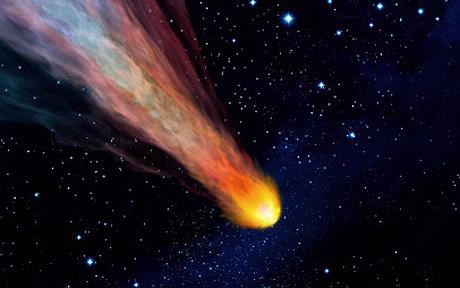Studying the different components of meteorites can provide key insights into burning questions about galactic chemical evolution, interstellar origins and timescales associated with the delivery of these objects to our home planet.
 |
| A meteor streaming across the night sky. Credit: Ian Mckinnell |
With the use of the OPAL research reactor, ANSTO’s research is looking at very small particles found within a meteorite called chondrules, which are about 1mm diameter, and even smaller nanodiamonds which, at around 2-3 nanometres in diameter, are not visible with the naked eye.
The chondrules and nanodiamonds are some of the oldest objects found in our solar system, having survived unchanged for billions of years. Chondrules were born in the earliest phase of our solar system, before the planets were formed. Nanodiamonds, embedded in the matrix of a meteorite, are even older than our solar system.
Chondrule research
ANSTO’s chondrule measurements are being conducted in collaboration with the Max Planck Institute for Chemistry (MPIC) in Mainz, Germany.
The research utilises the OPAL reactor to irradiate the chondrules and matrix material to determine their elemental composition using a technique known as neutron activation analysis. Combining these results with noble gas analysis measurements carried out in Mainz, allows the MPIC team to calculate how long the meteorite had been speeding through space.
This is the length of time from when it was smashed from its parent body, by a collision with a larger rock or asteroid, to when it landed on Earth. The scientists have determined this to be approximately 5-7 million years in the type of meteorites studied in this project.
Nanodiamond research
In a separate but related research program with the MPIC, together with the University of Vienna and ETH Zurich, ANSTO is collaborating in an international study into extremely pure nanodiamonds. The nanodiamonds are thought to have been formed more than 4.6 billion years ago in an ancient ‘core-collapse’ supernova explosion, being the final and most violent stage of a large star’s life.
During a supernova explosion a large amount of material is expelled.
As it cools down particles such as nanodiamonds may be formed within a very short time after the explosion. Knowing whether that time was hours, months or a few years after the explosion is critical to developing an understanding of galactic chemical evolution and the processes of dust formation.
When formed, these stardust grains show the isotopic imprint of the stellar burning stages of that star. Therefore, by measuring the make up of the nanodiamonds, you get a picture of the nucleosynthesis processes by which the heavier chemical elements were created (starting from hydrogen nuclei up to plutonium) and what had been occurring in the star that formed them.
All elements on Earth are a mixture of up to 150 previous star generations whereas elements trapped in meteorite nanodiamonds are the result of a single supernova event. Scientists can therefore dig into the nucleosynthesis processes that occurred to form these elements, knowing that their isotopic pattern was frozen out of just one star.
ANSTO’s tandem accelerator, ANTARES, is used to undertake very sensitive measurements to determine the composition and ratios of trace levels of isotopes in the diamond. The OPAL research reactor and neutron activation analysis allows trace amounts of platinum to be measured. These results will assist in establishing the origin of the nanodiamonds and understanding the processes that created them.
Published: 17/10/2011

